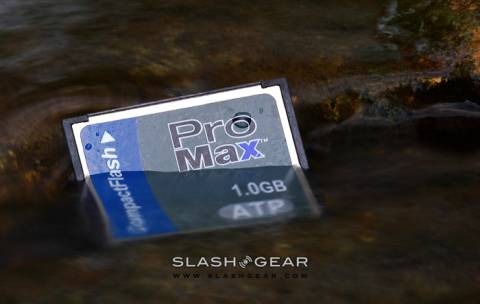ATP ProMax CompactFlash Review - Tough And Rugged
As a wildlife and bird photographer, I always reach for the best equipment manufacturers have to offer. I often wade in swamps and get soaked in seawater to get my shoot, hence weatherproof gear with high durability is most appreciated. ATP asked if I'd like to try their rugged CF card, a high-speed (150x), water-resistant non-volatile storage card that endures an extreme temperature range (-40 to 85 degrees Celsius). Hey! Sounds like my kind of toy!
So how fast is 150x and what's the real world performance that this compact flash can deliver? We put 2 of my most used CF into the test . Both are made by SanDisk; one is a 2g Ultra II and the other is an Extreme III. Both can read and write to my computer as well as store from my digital SLR camera. To get a fair result we took 3 sets of 10 continuous shots under equal artificial lighting. The result was timed and averaged. My professional grade Canon 1D mark II N and prosumer series 30D with default settings were used. The results are listed below, and as you can see the ATP Pro came on top in both cameras.

Next, we have the fastest card reader, the SanDisk Extreme which connects via Firewire, to time transfer rates from card to computer. SanDisk claim their reader is capable of 40m/s transfer speeds. To get a real-world comparison, we started running the test with the Mac Book Pro's Firewire 400; it was faster than a G5's Firewire 400 but we saw no difference in speed with Firewire 800. A Mac Dual G5 with the Firewire 800 interface was used for the rest of the test. Again, 3 sets of data were transferred and times averaged. The drive used in the G5 was a Western Digital 320GB Sata II. All cards were formatted with FAT32. Please note that all digital cameras use FAT or FAT-32 (the latter allows for individual files larger than 2GB) and that's why we used cards formatted that way. The results are slightly different to what I expected: the read and write performance varies from one card to another, with no clear winner on both read and write. One that's better in read may not do so in the write department. But again, the ATP pro trumps in the read test but is just a few seconds short in write performance.


If the speed and performance doesn't get your attention, I'm happy to say that the folks at ATP knew what they were doing when it came to withstanding extremes. The card survived several weekends of physical abuse. As I mentioned earlier, the work I do puts me and my gear in rough environments from time to time. While the spec doesn't say both operating and storage temperature will work at Texas heat, I nonetheless did push it beyond that limit without problem. I also simulated circumstances in a winter environment. After being stored overnight in the freezer, wrapped with ice packs, both my camera and the card reader were able to read/write the data just fine. As a side note, it did operate at a slower rate when the card was cold, but it started to pick up the speed after a few minutes warming up to room temperature. I did something stupid that I hope readers here don't repeat; I forgot to transfer the files I shot in the morning and took the shots you can see below. The whole card was completely under the water for 10 minutes while I prepared for the low shutter shot. I waited a few hours, let it dry out, and was able to get everything back. Hey, it's not that I don't trust the card but I got a few great shoots of Sharp-shined Hawks in flight and I'm not taking chances!

In conclusion, we really like this tough and speedy CF. It comes with a 5 year limited warranty and costs much less than SanDisk I've been using for the past few years. It works extremely well with my camera and is pleasingly fast in a card reader. I can't wait to get my hands on the bigger capacity models, like the 4 and 8Gb versions. We'll see...
